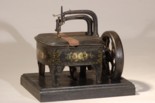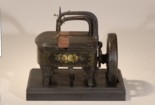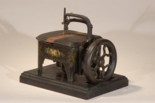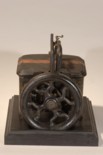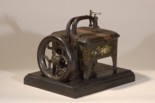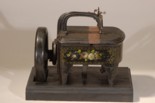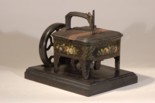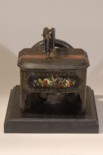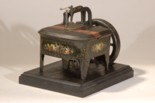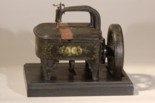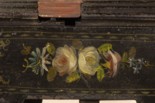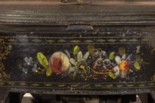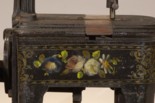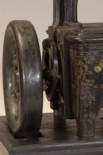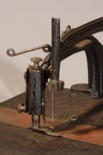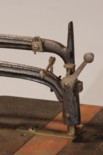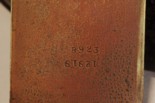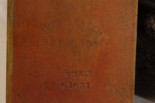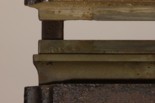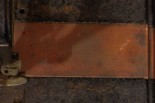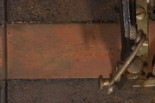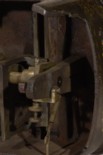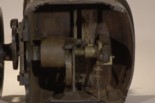Exceedingly rare and important Singer 1856 Turtle-Back Sewing Machine; one of eight machines extant. Sold!
There are currently only eight Turtleback sewing machines known to exist around the world, including this one offered here.
These antique Singer Turtleback machines were sold between 1856 and 1859 on a cast iron stand, or treadle, or in a wooden cabinet. The cast iron stand was very ornate with figural leaves along the legs on the side and it was the first sewing machine sold on a cast iron base. The machine offered here has the serial number 8923, see pictures # 17, 18, and 19.
The following patents are listed on the sliding plate covering the shuttle:
September 10, 1846; February 6, 1849; September 12, 1851; August 12, 1851; April 13, 1852; and May 30, 1854.The Turtleback is considered the Holy Grail among collectors; it is so rare because the machine was difficult to use and very expensive; this the reason why Isaac Singer recalled them with the offer of 100% money back no matter what the circumstances were with the intention to destroye them all; only very few survived. A few machines still extant lost their legs and worse.
Singer sold the Turtleback as Singer's NEW FAMILY SEWING MACHINE.
In a brochure dating about 1858 or 1859, Singer stated:
A few months since, we came to the conclusion that the public taste demanded a sewing machine for family purposes more exclusively; a machine of smaller size, and of a lighter and more elegant form; a machine decorated in the best style of art, so as to make a beautiful ornament in the parlor or boudoir; a machine very easily operated, and rapid in working.... To supply this public want, we have just produced, and are now prepared to receive orders for, 'Singer's new Family Sewing Machine.'Only two of the known Turtleback machine retained their original cast iron base, and only one its very decorated ebonized wooden cabinet, see book, "THE ENCYCLOPEDIA OF EARLY AMERICAN & ANTIQUE Sewing Machines, IDENTIFICATION & VALUES, Third Edition by Carter Bays," considered the bible in collecting early American Sewing Machines, shows on page 216, Fig.2-270 a Turtleback on its stand, and on page 217, Fig.2-271 a Turtleback with the same decorations as the one offered here in a cabinet (I owned this machine once).
Condition:
The machine retained most of its paint with the flowers on the vertical surface of the machine; the paint on the stitch-plate is mostly gone. The machine runs very smooth and besides the thread-holder and some little wires to guide and tension the thread, the machine is complete and without any damage. There is even a needle in the machine. The mechanism moving the needle up and down is unique and interesting to watch.
The mechanism is carefully cleaned with a fine brass brush and is free of rust.
The shuttle is missing.
History:
The first Singer machine specially designed for family sewing was sold by Singer as the "NEW FAMILY SEWING MACHINE" but commonly known as the "TURTLE-BACK," or "TURTLEBACK" and was produced from 1856 to 1859. It had a vibrating overhanging shaft, for actuating the needle-bar, and a reciprocating shuttle. Motion was given to the mechanism from the rocking treadle through a driving wheel carrying a broad leather belt capable of carrying much greater power than was required for its purpose.
Grace Roger Cooper referred to the New Family Machine also as The Grasshopper on page 35 in [1]. About five pages are devoted to the story of Singer starting on page 30 in [1].
Literature:
(Click on any title to see the online version of the book or publication if there is one.)
Inventory Number 09363;
Sold!
Prices realized in the past:
- There are no price results I could find.
